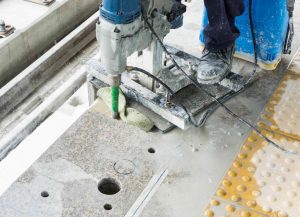In order to repair damaged or deteriorated concrete, it’s first important to understand why the concrete deteriorated in the first place. Without determining the underlying causes, you may set yourself up for the same exact thing happening again with the new concrete. The two main causes of poor concrete are placement issues and service condition issues.
Placement Issues
This common cause of concrete deterioration is not only a wear-and-tear concern but also a safety concern. Many concrete slabs with placement issues have problems with cracking. Cracking can be caused by a high water-to-cement ratio, faulty curing methods, a lack of proper substrate or subbase preparation, the timing of control-joint installation, or other placement factors. Cracking can also be due to design issues.
Common visible placement issues include:
- Bug holes: small holes or pits in the surface of the concrete due to trapped air bubbles on the surface of the concrete
- Rock pockets: weak concrete with water intrusion, corrosion on the reinforced steel inside, or voids inside caused by improper consolidation between the cement mortar and aggregates during the placement process
- Honeycombing: corrosion of reinforced steel, reduced resistance to abrasions, and potential for water damage caused by improper consolidation of concrete from lack of vibration or poor mixing
- Cold joints: water intrusion and corrosion of steel caused by a delay in the placement (visible lines and poor bonding between layers)
Service Condition Issues
There are numerous surface condition problems that lead to concrete deterioration, including:
- Corrosion of metals: appears as cracking and spalling in the surface of the concrete, caused by chloride intrusion, oxygen-water exposure, a drop in alkalinity, improper placement of rebar, or a corrosive chemical environment around the rebar
- Freeze-thaw: appears as scaling and delaminations, caused by concrete mixed with too much water and poured when the temperature was rapidly fluctuating between below and above freezing
GPR Services from Concrete Visions
Concrete Visions has over 12 years of experience and expertise in concrete scanning and we know how to detect any problems lurking beneath the surface. We use ground penetrating radar accurately and expertly and are familiar with many other methods that can be used when appropriate like concrete x-ray and electromagnetic conductivity. We are also very familiar with the latest construction safety techniques and train all of our workers to do their work quickly, accurately, and safely. If you would like to learn more about how we can help you, give is a call at (410) 766-2210 or visit us online. For more articles and tips, follow us on Facebook, Twitter, LinkedIn, and Google+.

